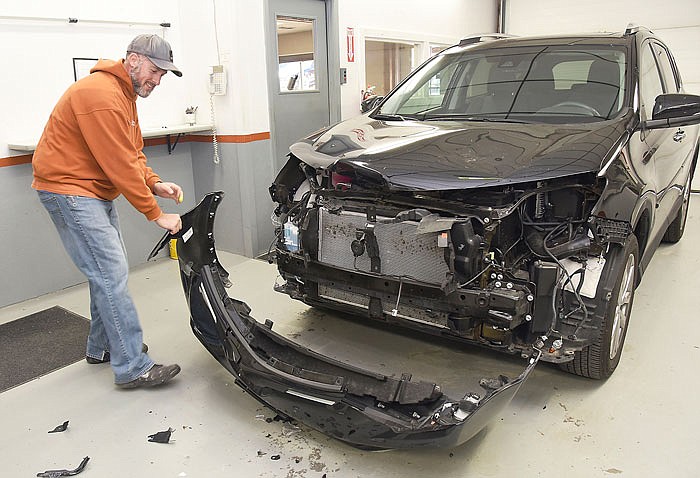Drivers beware: deer season means big business for Jefferson City body shops.
Body shops in Jefferson City said they have seeing a yearly increase in traffic as the annual deer rut, or mating season, is in full swing, as deer are often too pre-occupied to notice oncoming traffic when crossing roads.
Tanner Kemna works as an estimator at Kemna Collision Repair in Jefferson City. Kemna said Monday his father, Greg, who owns the shop, was in and out all day taking repaired cars to customers who had hit deer.
Most deer-related crashes occur in October and November. Kemna said traffic at the repair shop increased toward the end of October, just like it does every year.
"We're swamped," he said. "It's really picked up the last two weeks. Probably twice as busy as we normally are right now."
Devin Fischer, general manager at Fischer Body Shop, said traffic also picked up for him in the last two weeks. "Pretty crazy right now," he said. "It's always this busy every year."
On average, deer strikes occurred every 1.9 hours in Missouri last year, said Missouri Highway Patrol spokesman Sgt. Scott White. Six fatalities and 455 injuries occurred last year in 4,604 deer strikes statewide, according to the Highway Patrol.
Damage from deer strikes can be extensive. Kemna Collision Repair has a pile of front bumpers from cars struck by deer. Out front Monday an un-drivable Toyota RAV4 sat with its front bumper off and other extensive damage to the front end. On its right sat a Kia with minor damage to its grill, front bumper and hood. In between, parts of the splintered and pinched plastic and metal, a smattering of brown hairs protruded from the body of the car.
Kemna and Fischer said they've seen deer damage to about every part of cars. They also said it's unpredictable how and where on a car damage will occur in a deer strike. Many times the damage is simple damage to fenders, bumpers and body work.
In more severe cases, Fischer said deer can go into and through cars.
"Just about everything you can name, we've seen," Fischer said.
Fischer said most cars are salvageable, but some are not. Those cases often involve animals that go through windshields and defecate in cars.
"Just because you can't get the smell out, a lot of the time, they end up total (losses)," Fischer said.
Joe Jerek, spokesman for the Missouri Department of Conservation, said in recent years the statewide deer population stayed at about 1.2 million deer. The department estimates the statewide deer population did not increase or decrease significantly this year.
For white-tailed deer, the annual rut usually lasts about three weeks in the late fall. Bucks especially - but also does - tend to be more active and less cautious as they search for mates.
Most deer strikes happen between 5 p.m. and 6:59 a.m., according to a Missouri State Highway Patrol news release
"Hits don't just happen in rural areas," White said. "Any place where you have open, wooded areas, you can have close calls."
The Highway Patrol also said deer may be spooked by hunters or by crop harvesting.
Archery deer hunting season began Sept. 15 and ran until Nov. 10. It begins again Nov. 22 and runs until Jan. 15. The November portion of firearms deer hunting season began Nov. 11 and runs until Nov. 21.
When drivers encounter deer, they should understand there may be several deer, as they often travel in packs or in families.
Deer season typically kicks off the busiest time of the year for body shops. Fischer and Kemna said slick roads caused by snow and ice also typically create busy winters. Spring hail storms sometimes can bring business to the shops, but business typically cools off in the summer.
While the fall rut roughly lasts three weeks, Kemna said deer activity typically takes a few weeks to settle down.
"People need to be on the lookout and eyes peeled and eyes open for at least a month and a half," Kemna said.
More than anything, drivers should pay attention to the road.
"Be alert," White said. "That's a big one."

